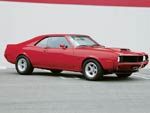
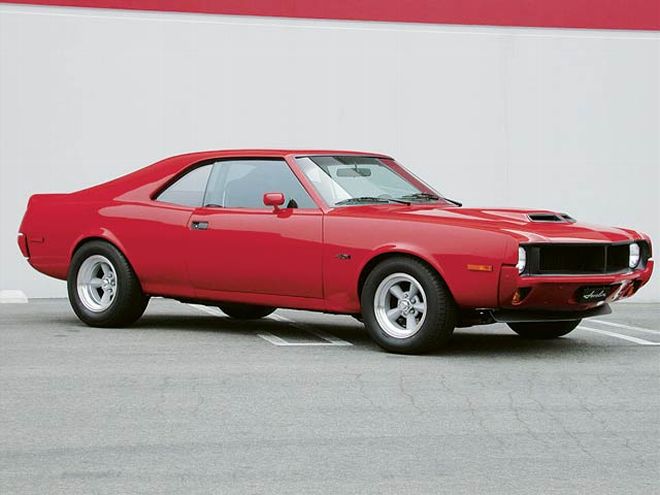 This is the car we drooled over: a '70 Javelin owned by Dennis Allen. He pulled the 304 and dropped in a 401 with all of Edelbrock's AMC trinkets. He converted the Borg-Warner to a 727 TorqueFlite automatic and used Matador police-car parts for brakes and a pair of chopped springs to get the ride height down. The differential is the stock Model 20. Dennis's Javelin uses American Racing TTOs, 15x7 front and 15x8.5 rear, and BFG tires on a common bolt pattern.
This is the car we drooled over: a '70 Javelin owned by Dennis Allen. He pulled the 304 and dropped in a 401 with all of Edelbrock's AMC trinkets. He converted the Borg-Warner to a 727 TorqueFlite automatic and used Matador police-car parts for brakes and a pair of chopped springs to get the ride height down. The differential is the stock Model 20. Dennis's Javelin uses American Racing TTOs, 15x7 front and 15x8.5 rear, and BFG tires on a common bolt pattern.
We wanted a Javelin bad. So we got all squinty and slack-jawed when we found a bunch of other Javelin guys on eBay bidding our Big Bad Blue '691⁄2 Go Pack dream car to death. Losing that auction got us thinking about the "wrong year" Javs and Ramblers we could buy cheap and plumb with beefed AMC running gear. Since our requisite engine for any AMC street machine is the 401, we went looking for alternative body styles that weren't coveted or even marginally collectible so we wouldn't feel guilty about yanking the stock engine for a big-cube swap-o. We didn't rule out the larger but still kick-butt Ambassador series or the Rebel, the big 'ol Marlin, or even the gas-crunch stuff from the '70s. We looked at models built after 1965, because stuff before that was just weird, and before 1977 when the Concord hustled in the age of the luxury compact that led to the ultimate demise of the auto division. Ugh.
So here's the deal: We dug up some archive photos of the cool musclecar-era body styles and listed some of the parts, tips, and tricks we found in our AMC fervor. There is way more information available than we can put in this story. So consider this a primer on what is possible. We're still trying to decide which one is coolest, so if we score a roller, we'll unite it with a screamin' mill and let you know.
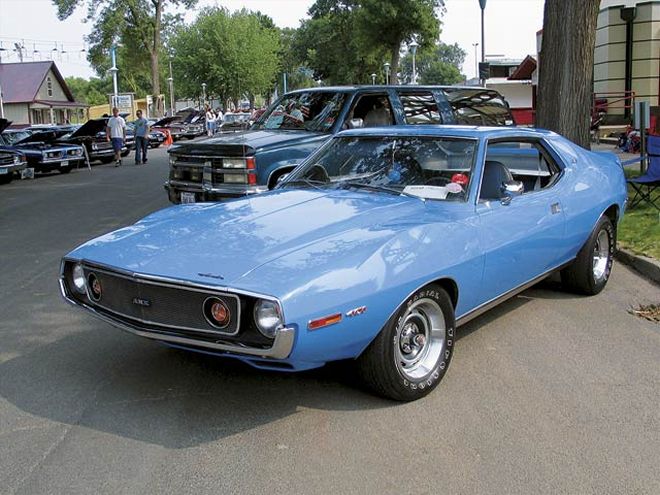 The alternative is this '74 Javelin owned by 19-year-old Brian Layden. It uses a 0.030-over 401 with 12.5:1 compression and Indy cylinder heads to run 13 flat at 109 mph on street tires. Somehow the Javelins avoided the '74 ugly bumper syndrome and got away with rubber guards instead.
The alternative is this '74 Javelin owned by 19-year-old Brian Layden. It uses a 0.030-over 401 with 12.5:1 compression and Indy cylinder heads to run 13 flat at 109 mph on street tires. Somehow the Javelins avoided the '74 ugly bumper syndrome and got away with rubber guards instead.
Body Styles
Like we said, the dream was buying a '68-'69 Javelin SST or AMX with a four-speed and either the 343ci or 390ci engine. Great cars, but we couldn't even find a rusty one that would make a good base for a street machine. Everything we found was either restored and expensive or returning to ore. During our search, we did find some Rambler Americans that came equipped with the small V-8s from the 290-360 family. Since the external engine dimensions are the same as the 401, a swap would be easy and their light weight would make them fly. We also found several of the less-coveted '71-'74 Javelins at reasonable prices and a Rambler Rebel SST convertible. Many of these cars were for sale for less than $4,000. Check out the cool bodies and consider the options.
Engines
All 290-401 AMC V-8s after 1966 are in the same family. But just because the 390-401s have the same dimensions as the smaller 290-360 engines doesn't mean you can bore and stroke your way to any cubic-inch displacement with any block. There are differences internally. The most notable is the switch from 7⁄16-inch head bolts to 1⁄2-inch head bolts and the deck height increase from 9.175 to 9.208 inches in 1970. This is actually OK because most of the aftermarket parts we've found are designed for post-'70 401s found in fullsize AMC passenger cars until 1974 and in fullsize Jeeps through 1978, making them more plentiful than the early engines.
Rearends
Most of the AMC V-8 cars were saddled with the ill-reputed 87⁄8 Model 20 rearend. The problem has always been that the axle is a separate component from the hub. To make matters worse, the axle uses a Woodruff key instead of splines, creating a potential to spin the axles in the hub and snap the key. Short of changing rearends, the fix we've seen used universally is a Detroit Soft Locker, Auburn differential, or similar design with a Moser one-piece 29-spline axle to put up with the abuse. If you're going racing with 500 hp or more and launching hard on slicks, there are Dana 60 and Ford 9-inch bolt-in housings available. Otherwise, upgrade the 20 and leave it alone.
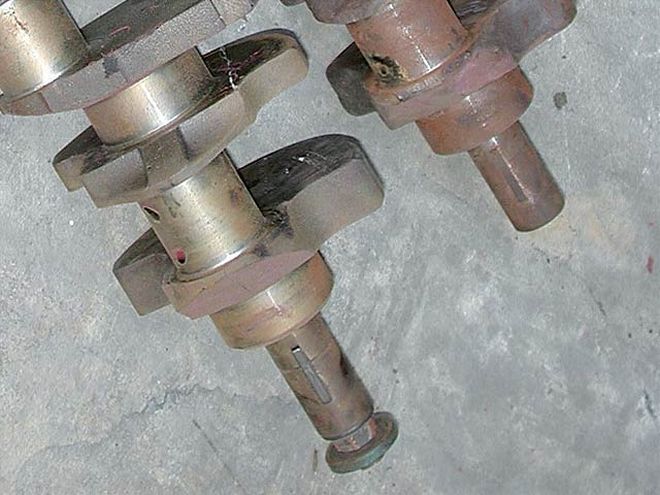 The 401 cranks and rods are forged and tough enough for a performance rebuild. Look for the 5.858-inch rods and the forging mark (left) on the crank. Builders have also been turning down the rod journals and using new 2.100 Chevy rods for performance 401s.
The 401 cranks and rods are forged and tough enough for a performance rebuild. Look for the 5.858-inch rods and the forging mark (left) on the crank. Builders have also been turning down the rod journals and using new 2.100 Chevy rods for performance 401s.
Transmissions
Early AMCs came equipped with the Borg-Warner Shift Command automatic or the T10 four-speed on the performance models. The T10 has always been a decent piece, but the Shift Command automatic shifts poorly and has little or no aftermarket support for performance use. The reason is that after 1972 you could get the TorqueFlite 727 Chrysler transmission with an AMC bolt pattern from a fullsize Jeep or AMC passenger car. With the door open to all the mainstream Chrysler speed goodies like converters, shift kits, and shifters, it's no wonder the early automatic is more for pleasant street cruising while the 727 is used for Friday night drag racing.
The easy way, of course, would be to pick up a catalog and order the 727 or even a 904, a converter, and a shifter and call it done. But if you're into it, Advance Adapters has an adapter to retrofit any GM trans, including overdrives.
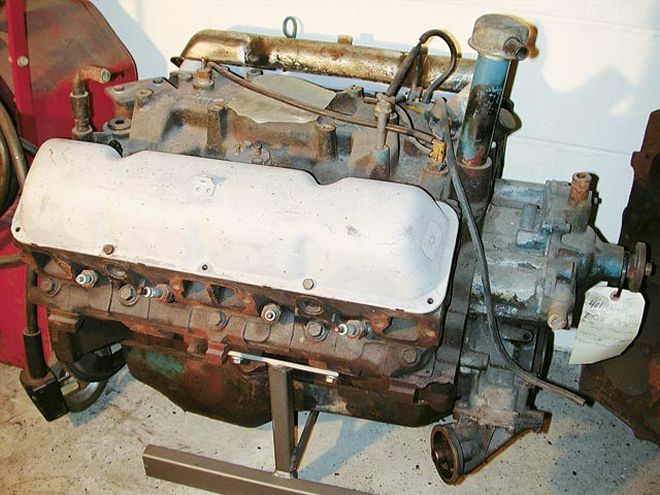 This is a stone-stock 401 from a '78 Cherokee. If you know what you're looking for, it isn't too difficult to score in the boneyard. The engine builders we spoke to told us building 450 hp at 6,500 rpm is no problem if you modify the oiling system to supply the No. 4 and 5 main bearings.
This is a stone-stock 401 from a '78 Cherokee. If you know what you're looking for, it isn't too difficult to score in the boneyard. The engine builders we spoke to told us building 450 hp at 6,500 rpm is no problem if you modify the oiling system to supply the No. 4 and 5 main bearings.
The standard transmission is a bit more straightforward; if you're lucky enough to score a four-speed T10 car, leave it in there. It also should be known that the T5 five-speed from late-model Mustangs and Camaros can be used with the stock bellhousing from the 401 AMC V-8. With a pilot bushing or flywheel swap, both are acceptable for performance applications.
Details
Finally, the dress-up. Unlike Big Three cars, AMC used the 5-on-4.5 bolt pattern on all its musclecar-era cars. This happens to be the same bolt pattern as Ford and Chrysler, so swap meets and any of the huge number of wheel makers can provide rims for an AMC. Also, because of the Jeep guys, you can score about any part for the engine in chrome. All good, just don't overdo it. CC
Barn Cars
We found several cars hidden in a warehouse right here in Los Angeles. Know what they are? Log on to carcraft.com if you think you do.